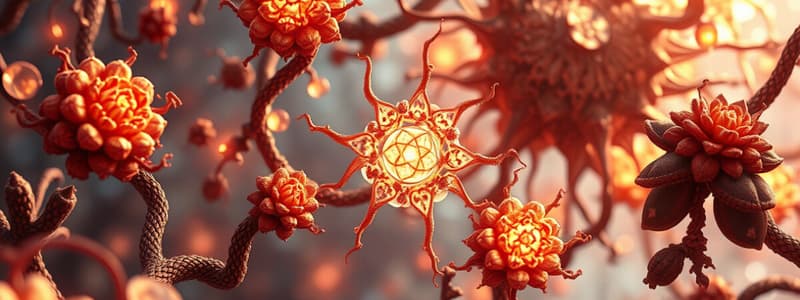Podcast
Questions and Answers
What is the primary function of the nucleolus in a cell?
What is the primary function of the nucleolus in a cell?
It manufactures the cell's protein-producing structures and ribosomes.
What role do nucleopores play in the nuclear envelope?
What role do nucleopores play in the nuclear envelope?
Nucleopores allow proteins and nucleic acids to pass through the nuclear membrane.
How do mitochondria generate usable energy for the cell?
How do mitochondria generate usable energy for the cell?
Mitochondria harness energy from the oxidation of food molecules to produce ATP.
What is the structure difference between the outer and inner membranes of mitochondria?
What is the structure difference between the outer and inner membranes of mitochondria?
What distinguishes chloroplasts from other organelles in eukaryotic cells?
What distinguishes chloroplasts from other organelles in eukaryotic cells?
What is the primary energy product of mitochondria during cellular respiration?
What is the primary energy product of mitochondria during cellular respiration?
How does DNA differ in prokaryotic cells compared to eukaryotic cells?
How does DNA differ in prokaryotic cells compared to eukaryotic cells?
What is the significance of the inner membrane's folding in mitochondria?
What is the significance of the inner membrane's folding in mitochondria?
Why are mitochondria considered the powerhouses of the cell?
Why are mitochondria considered the powerhouses of the cell?
What role do chloroplasts play in the energy cycle of a plant?
What role do chloroplasts play in the energy cycle of a plant?
Study Notes
Photosystems
- PSII (Photosystem II) absorbs light best at 680 nm; PSI (Photosystem I) absorbs at 700 nm.
- Visible light spectrum ranges from 380 to 700 nanometers.
Endoplasmic Reticulum (ER)
- ER synthesizes components vital for eukaryotic cells and is critical for protein secretion.
- Continuous with the nuclear envelope membranes.
- Rough ER is ribosome-studded, while smooth ER lacks ribosomes.
Protein Synthesis
- Protein synthesis takes 20 seconds to several minutes, with multiple ribosomes often binding to a single mRNA.
- Eukaryotic ribosomes are 80S (40S small subunit and 60S large subunit) compared to prokaryotic (70S).
Peroxisomes
- Small, membrane-enclosed vesicles that create a safe environment for reactions involving hydrogen peroxide.
- Contain enzymes specifically for peroxide metabolism.
Protoplasm
- The living content of a cell within the plasma membrane; composed of ions, amino acids, monosaccharides, water, macromolecules.
- Responds to stimuli like heat and chemicals.
Cytoplasm
- A semifluid, gelatinous substance constituting about 80% water, often clear and colorless.
- Suspends organelles and contains dissolved nutrients and waste products.
- Major metabolic pathways, including glycolysis and cell division, occur here.
- Facilitates cytoplasmic streaming, which promotes solute exchange and long-distance transport within the cell.
Nucleus
- The most prominent organelle in eukaryotic cells, containing DNA that encodes genetic information.
- Membrane-bound structure exclusive to eukaryotes; vital for DNA storage, cell division, and metabolism.
- Contains a nucleolus for ribosome production and nucleopores for nucleic acids and proteins transport.
Mitochondria
- Present in almost all eukaryotic cells, notable for their dual membrane structure.
- Generate chemical energy through the oxidation of food molecules to produce ATP and GTP, vital for energy transfer and signaling.
- The inner membrane has folds, increasing surface area for cellular respiration processes.
Chloroplasts
- Large, green organelles found only in plant and algal cells responsible for capturing solar energy for photosynthesis.
Studying That Suits You
Use AI to generate personalized quizzes and flashcards to suit your learning preferences.
Related Documents
Description
This quiz covers the essential functions of the two photosystems in photosynthesis, including their absorption of light at specific wavelengths. Additionally, it explores the role of the endoplasmic reticulum in eukaryotic cells, particularly in protein secretion.




